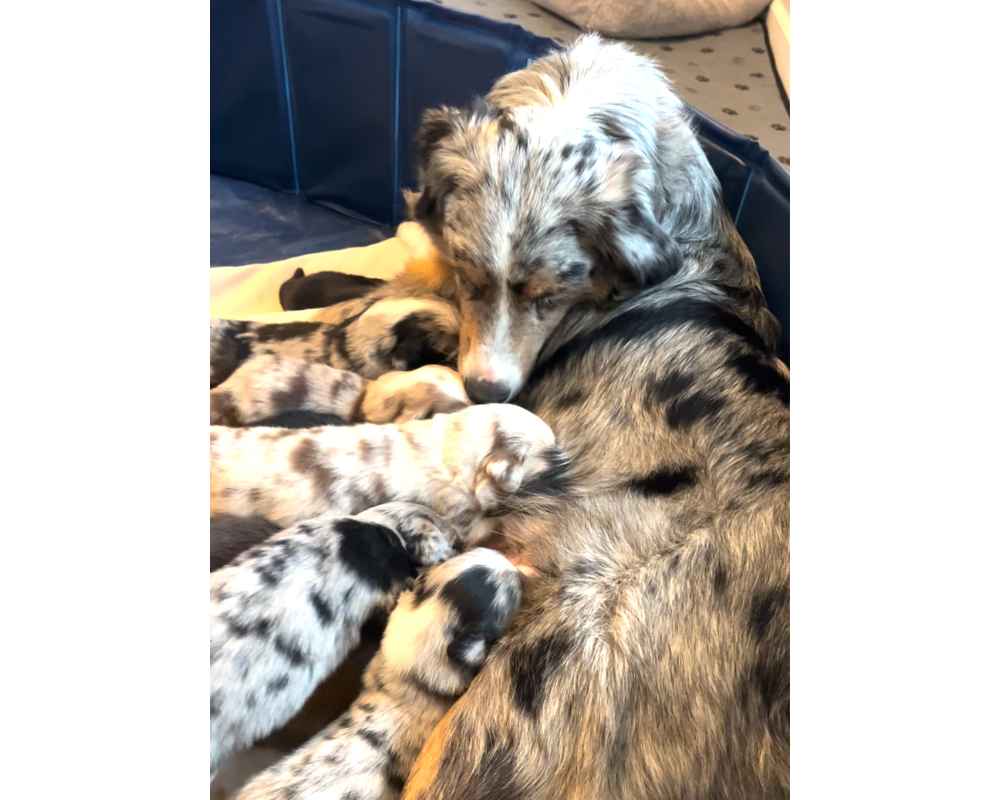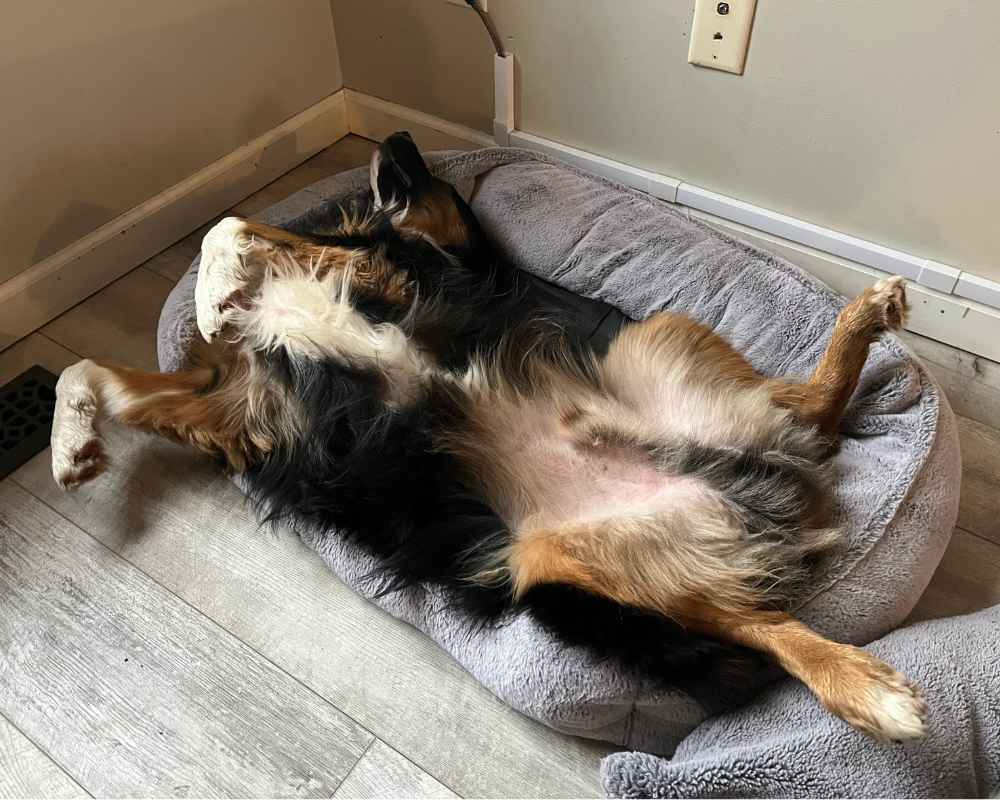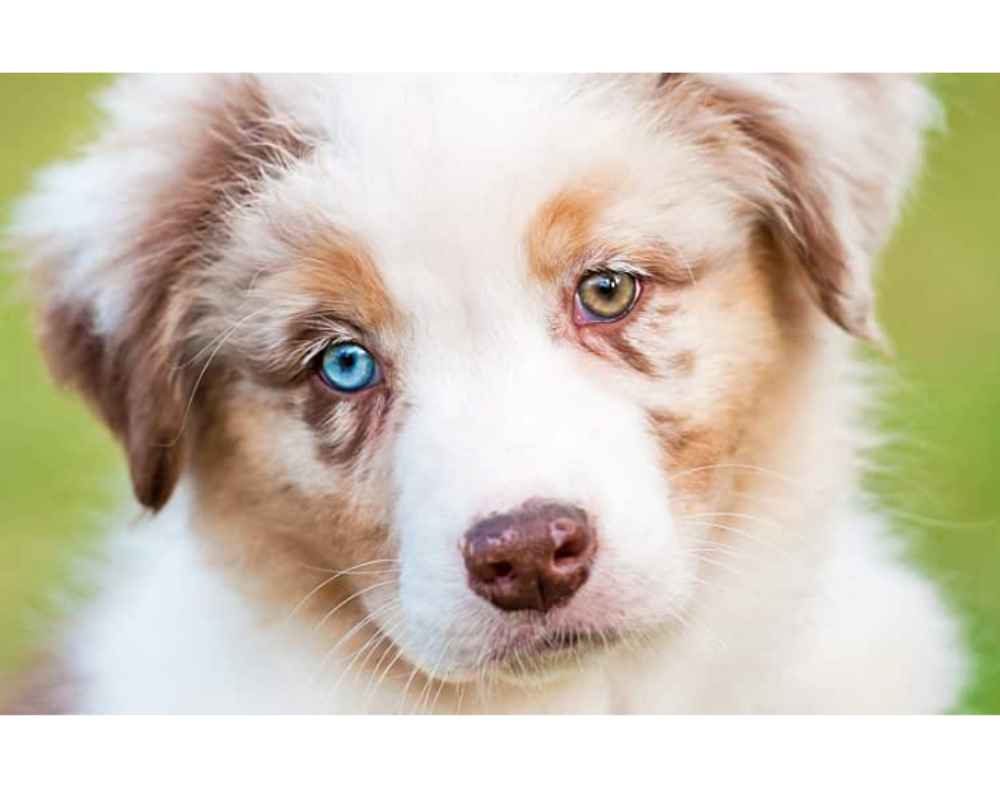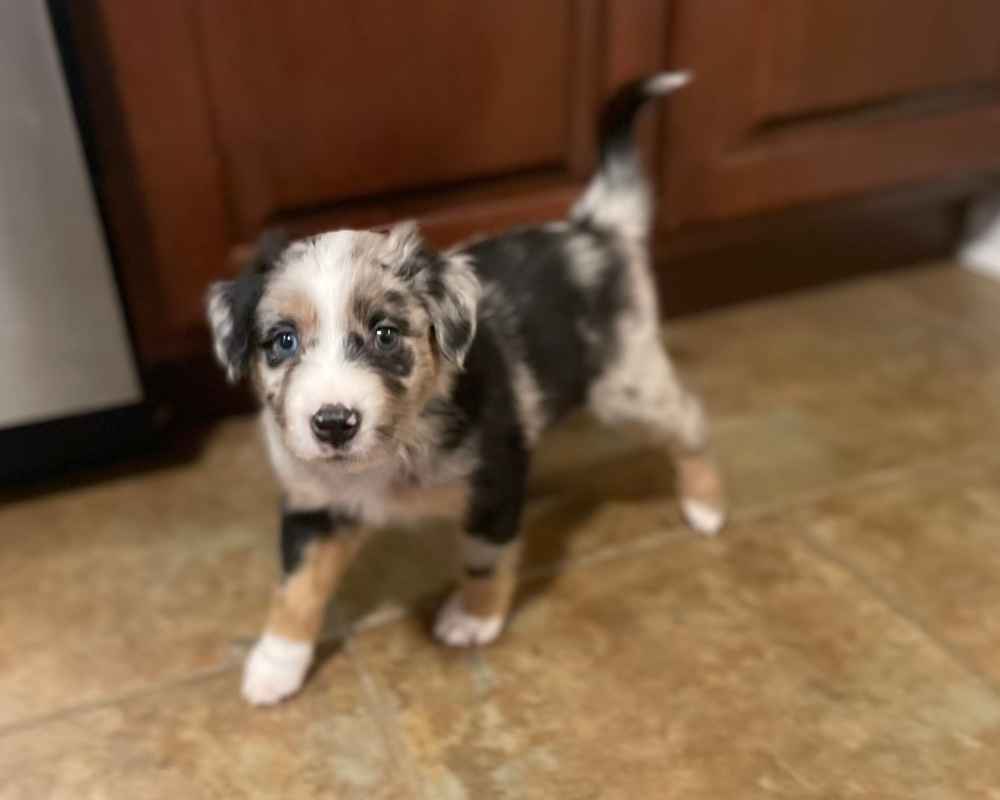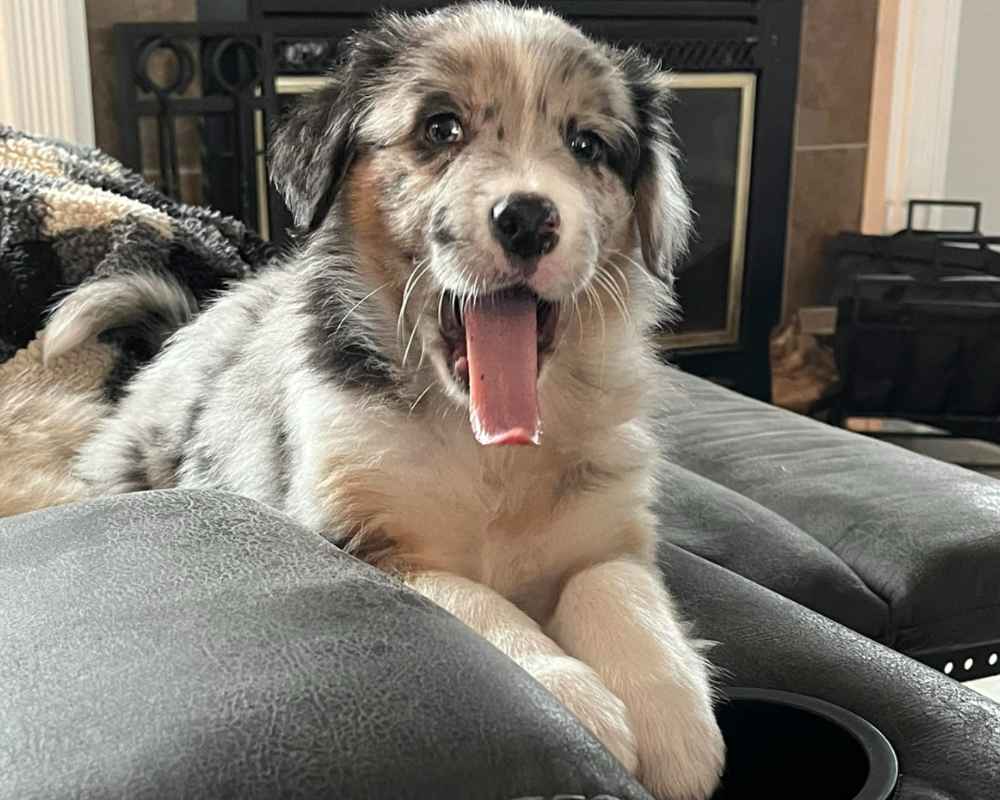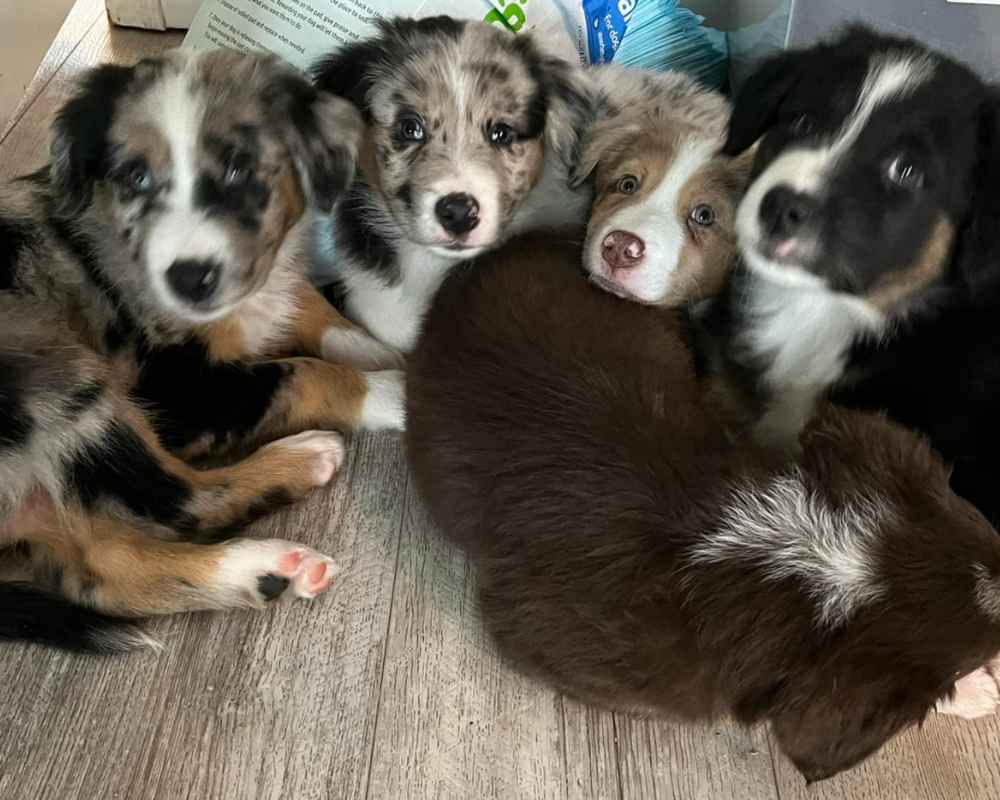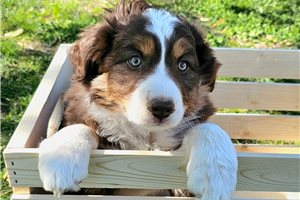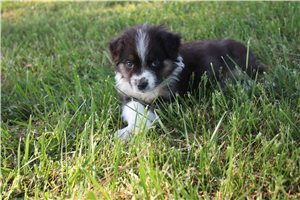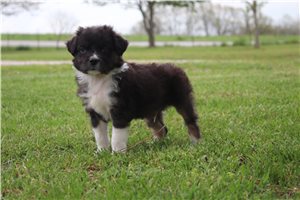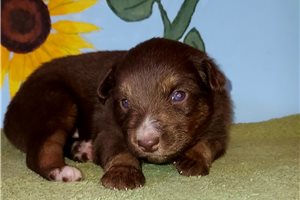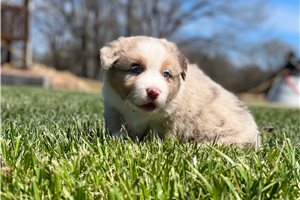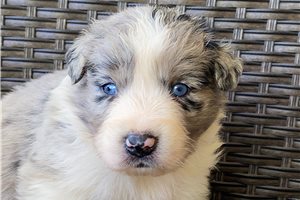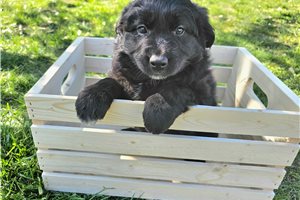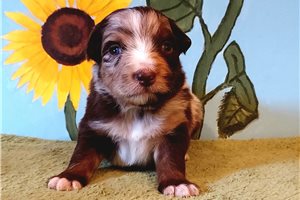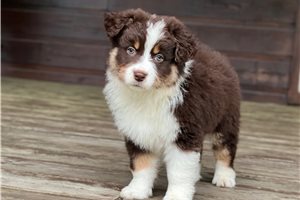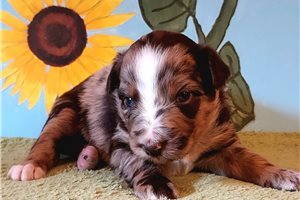One week before Thanksgiving, Pawrade received exciting news! On November 17, 2023 a new litter of Australian Shepherd puppies was born with one of Pawrade's favorite puppy home breeders; something to be thankful for. It was the perfect opportunity to collaborate with them and document the puppies’ upbringing, growth, and development. What goes on behind the scenes is crucial to successful puppy ownership for the thousands of people Pawrade works with every year. In the face of concerns about puppy mills and backyard breeders, Pawrade is serious about eliminating these as options for people to get a puppy from.
This article (and Pawrade Breeder Interviews) provides valuable information about the ins and outs of being a home breeder. Watch clips of the puppies as they grow up and don’t miss the full breeder interview with Tara and Josh!
You can become a Pawrade breeder too! This article gives an in-depth look at the hard work and dedication expected from every breeder that Pawrade represents, as well as a blueprint of expectations and routines for a puppy's development from birth to 8 weeks of age.
The birth of puppies
The Australian Shepherd puppies nurse from the Australian Shepherd dam
Like any birthing moment, the high levels of joy and stress are mixed emotions muddled together in a warped heart race. Dog births require an acute sense of patience and understanding from the breeder due to the language barrier—for lack of a better term. Simply put, Mother Nature works her course and all one can do is marvel at the innate strength of the dam (mother dog). What you might not think about is the noise and...not to be gross, but...the blood that comes with the birth of beautiful puppies. In real-time, you become the parent, the doctor, and the caretaker.
“This litter felt like a miracle,” Tara told Pawrade. “We came home as a family and found Marshall and Miley together as new doggy parents with 8 beautiful puppies. There was so much excitement,” Tara said with a glow in her eyes before pausing, “...and quite a bit of cleanup! But the colors of the babies and the look on our mama’s face was our peace of mind.”
The Australian Shepherd dam watches over her Australian Shepherd puppies as they nurse their first meal
The Australian Shepherd sire relaxes after the puppies are born
Should the breeder help a dog give birth?
Tara and Josh have always been present when past litters were born. Yet there was something magical and naturalistic about this time around. With a full family of 7, Tara mentioned that it can be an added challenge containing the emotion during a puppy birth. Coming home to a brand new doggy family was surreal and she wondered if the silence and solitude helped her mama dog push through effortlessly.
Typically, breeders do not need to assist the dam during labor. Supervised births are best since there are a few steps to delivering a puppy that need to occur right away. Puppies are born within a membrane, the amniotic sac, that needs to be removed for the puppy to breathe. Mother dogs instinctively know to clean their pups, which is why they lick at the faces and nostrils of their babies. The umbilical cord also needs to be detached; the mother dog knows to nibble at the cord to break the puppies free from the umbilical cord. Breeders may monitor and assist these behaviors to ensure a smooth birth.
Nevertheless, breeders must take full responsibility for the success of their sire and dam and the wonderful introduction of their puppies to the world. Canine neonatal mortality is a devastating reality that breeders can help prevent with the advances in medicine and prenatal care that are available in today’s world. The fact of the matter is that giving birth to 6 or more lives is not an easy task! Puppies from larger litters may be more vulnerable to not receiving sufficient nutrients or timely attention from the dam. Fading puppy syndrome is a natural occurrence that breeders must prepare for. Between the two, studies determine that 20-30% of puppies may fail to thrive and survive past their first week of life.[1] This is why breeders rejoice when a full litter of puppies is born in good health.
Tara and Josh have had exceptionally good fortune in their years of breeding. By choosing healthy breeding dogs and providing outstanding care, they feel blessed with the healthy litters they have raised. Despite their absence during the birth of this litter, they know every moment of preparation and love poured into their Miley and Marshall paved the way for a healthy litter.
The Australian Shepherd litter cuddles up with their mom at the end of the day
1. Blunden, Tony (2012). "Fading puppies – reality or myth?". In Practice. 34 (6): 314–321.
1 week old puppies: one day at a time
The first week is filled with shared curiosity between the puppies, the parent dogs, and the breeder! Every hour of every day demands the breeder’s full attention. Delicate hands and preparative minds cooperate together to ensure each puppy is nursing, sleeping, moving, breathing…and pretty much anything you can think of. During the first week of life, puppies only have a sense of taste and most likely some sense of touch. Their eyes haven’t opened so they cannot see and their ear canals are closed so they cannot hear, so they typically stay close to each other and their mother. The mom dog enjoys feeding her pups comfortably inside a whelping box. Designating a safe space for the dam and her puppies is a crucial first step in meeting the instinctive needs of the dogs.
Although newborn puppies sleep up to 22 hours a day, their fragility means the breeder should be on constant watch. Guaranteeing every puppy is nursing can feel like a full-time job considering newborn puppies need to eat once every 3 hours. Body heat is also vital since newborn puppies do not regulate their body temperature until after the second week of life; keeping puppies grouped together and close to their mom often requires a lending hand from the breeder.
Five out of the eight Australian Shepherd puppies for sale sleep in the warmth of Josh's arms
Buster, the blue merle Australian Shepherd puppy for sale, finds a comfortable napping spot
Puppy goes potty
Puppies usually have no problem with urinating as soon as their bodies need to. However, helping puppies urinate and defecate is another task at hand. The puppies need warm stimulation to relieve themselves which is often provided naturally by the mama dog's licking, but can also be given by the breeder. Gently rubbing warm cotton balls between the back legs of the puppies is one of the best ways to help a newborn puppy poop, as this mimics the feeling of the mama's tongue. As a breeder, constipation should be and can be avoided by keeping the puppies nurtured by the dam and keeping a close eye on the litter.
2 week old puppies: too cute!
Being a breeder is an eye-opening experience, pun intended! Puppies begin opening their eyes around 10 days old. Australian Shepherds are known to boast beautiful eye colors, like blue, hazel, green, and sometimes “heterochromia” (when one eye color is different than the other eye color). The anticipation is always great. “We knew that breeding a tri-color and a merle Aussie would give the best potential for a variety of coats and colors,” explained Josh, “and waiting to find out the eye colors of each puppy is an added joy.” Tara added, “Eye contact is so important with dogs since they can’t use words. The first glimpse into their eyes is remarkable.”
As Forrest Gump famously put it, you never know what you’re gonna get. This is certainly true with the genetics of Australian Shepherd puppies!
Heterochromia in an Australian Shepherd puppy
Opened eyes are accompanied by opened ears. Nearly simultaneously, puppies start to see at the same time they start to see. From an evolutionary perspective, it makes sense that these intertwined senses begin developing at the same pace. Sight and hearing play an intricate role in a puppy’s socialization with the parent dogs and the littermates. Tara and Josh love the first moments as puppies begin to notice each other, their environment, and their parents.
Home-breeders like Tara and Josh begin to introduce the normal noise of everyday life to their puppies. The ‘sss’ of running water from the faucet, the ‘boom’ of doors closing, the ‘ding’ of pots and pans, and the voices from television and family life fill the rooms in the home. In this case, less is not always more. Early neurological stimulation for puppies introduces a variety of sights and sounds to the puppies. As a result, the transition from the breeder's home to a family’s home becomes easier for each puppy.
Puppy dewormer
At the tender age of two weeks, the first round of puppy dewormings is administered. This helps guard against intestinal parasites such as roundworms, hookworms, and tapeworms. Internal parasites can lead to malnutrition, stunted growth, and a weakened immune system in puppies. By implementing a proactive deworming schedule, breeders and pet owners take a preventive stance against potential health issues, fostering a strong and resilient start for the young canines.
Pawrade breeders understand the necessity of deworming puppies and follow a regular administration of dewormers, ensuring the continuous elimination of potential parasites that could hinder the puppies' growth and development. Deworming treatment should be done at 2, 4, 8, and 12 weeks of age followed by 4, 5, and 6 months of age. As puppy dogs get older, they should always be on a regular flea, tick, and heartworm preventative as well.
Puppy muscle development
Furbabies remain feeble during their second week of life. Only their front legs and paws gain motor control, which marks their “first steps”...often towards their mother for feeding! Wobbly attempts at standing and walking start to transform into more coordinated movements. Those tiny paws, once uncertain, now take deliberate steps, showcasing a newfound sense of balance. It's a heartening sight for any observer, witnessing these miniature explorers embark on their first adventures around the whelping box.
The Australian Shepherd puppies sniff around and test their senses in the whelping box
3 week old puppies: puppy, parent, and breeder
This stage of puppy development is arguably the most fun. At 3 weeks old, things start to change for the better. For example, puppies stand on all four legs at 3 weeks old and puppies show personality at 3 weeks old. Alas, puppies have reached the beginning of their critical socialization period which persists throughout the next 2 months of their lives. With their growing strength and coordination, the puppies engage in more spirited play. Littermates become playmates, engaging in gentle wrestling matches, adorable tumbles, and playful pawing. These interactions are not only entertaining but also vital for the development of social skills, cooperation, and the establishment of a pecking order within the litter. Some puppies may display a more adventurous spirit, while others prefer cozy corners for naptime. These unique traits, though subtle, offer a glimpse into the diverse personalities that will continue to develop as the puppies grow into adulthood.
Brie, the red merle Australian Shepherd puppy for sale, gains strength in her front legs and hind legs
Manchego, the tri color male Australian Shepherd puppy for sale, stretches his legs during a growth spurt
Sharpened Senses
The third week also marks a significant advancement in the puppies' sensory capabilities. Eyesight becomes clearer, allowing them to track moving objects and focus on their littermates. Ears are more attuned to sounds, and their little noses, always inquisitive, explore scents with curiosity. The whelping box, once their entire universe, now serves as a launching pad for their exploration of a broader world.
Nursing and Comfort
While the puppies become more independent, the mother's role remains pivotal. Nursing sessions continue to provide essential nutrition, and the mother's presence offers comfort and guidance. The bond between the puppies and their dam deepens, laying the foundation for a secure attachment that will influence their future relationships with humans and fellow dogs. Keeping close to their mother takes up the majority of a 3-week-old puppy's routine, however, they may start poking their heads over the walls of the whelping box to see what else the world offers.
The litter of Australian Shepherd puppies continues to socialize together in the whelping box
4 week old puppies: halfway there
The fourth week of raising puppies is a milestone for breeders. Puppies are now halfway to the day they are allowed to go to a family! There are many reasons as to why puppies should never go home before 8 weeks old and Pawrade takes this seriously.
Noticeable differences in the puppies are displayed by each precious pup in the litter. The puppies have started to navigate their surroundings; they respond naturally to activity around them; their first teeth start to appear; and start eating solid food. Distinct personalities of each puppy become increasingly evident; some may showcase a natural affinity for leadership, while others adopt a more laid-back approach to life. Whether they're the adventurous explorer or the gentle observer, these individual quirks add depth and charm to the dynamics within the litter.
Tail-chasing, gentle wrestling matches, and spirited pawing sessions become a daily occurrence, providing not only entertainment for observers but also essential socialization experiences that contribute to their well-rounded development.
Week of weaning
As mentioned above, puppies should be weaned to solid food once they reach 4 weeks of age. While the mama dog’s influence remains significant, puppies begin to explore solid foods, marking a pivotal step toward self-sufficiency. The dam, ever watchful and nurturing, encourages their fledgling independence while providing her comforting presence.
There are a variety of ways of how to wean a puppy. Generally speaking, the puppies should be separated from the dam during feeding time. The new food should contain a mix of canned or wet dog food, or water, or canine milk replacer, or all of these. Breeders are recommended to work with their veterinarian to decide what works best. Learning that their food source will be separate from the mother dog is a critical step in the mental and physical development of the puppies.
Expressive communication
As the puppies continue to interact with their littermates and the world around them, their communication skills become more nuanced. Expressive barks indicate hunger, playful growls communicate to littermates, and even subtle body language conveys a wealth of information, establishing a foundation for effective communication in their canine social circles.
Bleu, the red tri Australian Shepherd puppy for sale, looks up with the classic "puppy eye" gaze
Cheddar, the blue merle Australian Shepherd puppy for sale, perks up at the sound of dinner being served
Breeders maintain a watchful eye on the puppies' health and well-being during this crucial stage. Socialization efforts intensify, exposing the puppies to diverse stimuli, human interactions, and environmental experiences that contribute to their overall resilience.
"Week four starts to feel entirely different," said Josh. "We get the chance to start building bonds with each puppy since their awareness grows and their dependence on Tara, our boys, and I strengthens."
5 week old puppies: more alive than ever
Five-week-old puppies have now earned the right to fearlessly explore a new stage of life. By the fifth week, these little adventurers have started to find their true identities. Their tiny frames have transformed into sturdy bodies and their coordination has reached a new stage of development. The whelping box is now too confining for their boundless energy, and breeders must design areas for socialization and play to foster the puppies' spirited escapades. Climbing and hopping become second nature, and their agility is on full display as they navigate obstacles with finesse. Each day brings fresh triumphs as the puppies master the art of balance and coordination, building the foundation for the playful adulthood that awaits them.
Individual Quirks Shine
The fifth week is a kaleidoscope of personalities. Some puppies may reveal a penchant for leadership, while others embrace a more laid-back approach to life. The quirks that make each puppy unique become increasingly apparent, adding a layer of charm and individuality to the dynamics within the litter. Littermates engage in lively interactions, forging bonds that will last a lifetime. Games of tag, gentle wrestling matches, and shared exploration become the norm, fostering a sense of camaraderie and cooperation. These playful interactions not only contribute to the puppies' physical development but also lay the groundwork for harmonious relationships in their future homes.
6 week old puppies: in the mix of it all
The excitement heightens at Week 6! Breeders continue to help expand the puppies' environment. For example, puppies at this age are given their first round of vaccinations, which usually means their car ride to their first trip to the vet.
Puppy Vaccines
Tara and Josh's son comforts Bleu, the red tri female Australian Shepherd puppy for sale, at the veterinarian's office
At this stage of life, since puppies are now given the freedom to go outside more, they receive their first round of vaccinations. Generally speaking, most breeders choose the DHPP 5-in-1 shot for the first round of core vaccines needed to keep a puppy healthy, as this guards against common puppy illnesses that you should know about: Canine Distemper, Adenovirus types 1 and 2, Parainfluenza in dogs, and Parvovirus. Puppies need one or two days to adjust to this vaccination, then they are ready to get back out there! For extra precaution, the American Veterinary Society of Animal Behavior (AVSAB) recommends puppies go outside as early as one week after their first round of vaccinations. Once the vaccines have settled in, doors open to let the puppies meet the great outdoors.
Puppy play
“Raising puppies in your home might look glamorous, but it’s a lot of work,” Tara said in response to potty training. She proceeded to motion her hands in all directions of the room, where puppy pads were laid out and taped to the floor. “We have learned to offer immediate reinforcement, like belly rubs and positive words, after we help a puppy finish the job over a pad."
Once the puppies have proven they are ready to expand their daily life outside of the whelping box, breeders must welcome more duties. Additional places to go means puppies can begin potty training on puppy pads and outside. Remember, puppies gain control of their bladder at around 16 weeks of age, so breeders must supervise their puppies and redirect them to potty pads or an outside area as soon as they notice a puppy start to trickle. Repetitive exposure is key in the early stages of learning for the puppies.
The Australian Shepherd puppies experience snow for the first time
Matching energy
Energy levels grow as the puppies chase, tumble, and engage in spirited games with their littermates. Each interaction is a joyful display of their growing coordination and agility, creating heartwarming moments that captivate both breeders and future pet parents.
Most dog breeds are naturally pack animals. Like a noisy playground full of kindergarteners, they navigate social structures through trial and error. Can I land this jump? What happens if I bite my brother’s tail? Will I get in trouble for barking too loud? It’s like you can watch the train of thought as it happens. As the puppies sniff out new places to play, you frequently see them move about in a clump, like a furry amoeba making its way into uncharted territory.
Merle Australian Shepherd puppies for sale and tricolor Australian Shepherd puppies for sale from the litter hug while waiting for puppy treats
7 week old puppies: puppy heaven
All of a breeder’s hard work truly starts to pay off by Week 7. With only one more week left until the puppies can be picked up or delivered to their respective homes, the final touches are all that’s left. Tara and Josh use this week to start training practices that create the foundation of a puppy's agreeableness to toys, regular food, and commands. After all, 7-week-old puppies seek authoritative guidance after the previous weeks of free play and intrinsic learning.
Puppy teeth
Answers may vary, but it is safe to say that a puppy’s deciduous teeth will be fully erupted in Week 7. So begins a puppy’s teething stage! Strong and sharp teeth require a lot of stimulation; it is important to give the puppies acceptable things to chew on. Shoelaces, cords, and fingers should never be freely available. “Puppies constantly need redirection,” explained Tara. “They learn equally from us as breeders as they do their mama and each other.” Early lessons in what’s okay to chew on and what’s not okay to bite on can last the lifetime of a puppy. Once you know your puppy's preferences, you can find the best puppy toys to surprise him or her with!
Manchego, the black tri Australian Shepherd puppy for sale, uses a soccer ball puppy toy to appropriately stimulate his teething
Fully weaned
Safe eating pertains to both the puppies and the mother. In this case, after several weeks of nursing, the mother dog’s nipples may be extra sensitive to the sharp teeth of the babies. Breeders must make a conscious effort to fully switch the puppies’ diet to regular food.
During the Pawrade breeder interview with Josh and Tara, they displayed just how wild lunchtime can get! “Over the years, we have found many benefits of soaking puppy food in water before feeding time.” For example, this helps soften the food for easier digestion and also helps with the intake of water.
Puppies should also be depending on regular food at this age because they won’t have access to nursing their mother in their new homes. As obvious as this is, it helps explain the puppy growth timeline.
Commands
Another precursor under the breeder’s watch is the beginning of obedience training and leash training. This critical phase in a puppy's life provides the perfect window for teaching them essential behaviors and commands that will shape their interactions with the world. Obedience training not only instills basic commands like sit, stay, and come but also helps to establish a strong bond between the puppy and its future owner for fostering trust and understanding.
Australian Shepherd puppies obey the command "sit" for the families waiting to pick them up
Leash training introduces puppies to the concept of walking alongside their owners in a controlled manner. To start, puppies will drag a leash behind them as they run around and play. The next phase a breeder will take is to control the leash and usher guided movements for the puppy to follow. This early exposure to leash etiquette prevents potential behavioral issues and ensures that the puppy grows accustomed to the external environment in a controlled and safe manner. Moreover, it aids in teaching puppies to respect boundaries and respond positively to non-verbal cues, setting the stage for a harmonious relationship with their new owner. By initiating these training practices at 7 weeks of age, breeders contribute significantly to the puppy's behavioral development, setting them on a path to becoming well-adjusted, socially adept, and obedient adult dogs.
8 week old puppies: the wait is over
As the eighth week unfolds, the puppies are ready for the next exciting chapter—the journey to their forever homes. Families eagerly await the arrival of their new furry companions, armed with enthusiasm, love, and the promise of cherished moments. The handover is a joyous occasion, marking the beginning of a lifelong bond between humans and canines. Once in their new homes, the puppies adapt to their surroundings with remarkable resilience. Familiar scents, loving faces, and a bounty of toys await them, creating a welcoming environment. New owners play a vital role in providing love, care, and a sense of security, ensuring a smooth transition for the puppies.
Josh said, "That's the special touch that we focus on: trying to partner people with personalities that are going to work with our puppies. And I think that's something Pawrade and us have in common, honestly."
"We have dogs like Bingo and Mooncake that go to service dog work, we have dogs that go to farms, we have dogs that are just for companionship, so it's cool to see all the different things that they can be used for. I think that is one of my favorite things," added Tara.
Bingo is a black tri color Australian Shepherd dog trained as a gluten-detection service dog
Mooncake is a blue merle Australian Shepherd dog trained to alert owner for PTSD, panic, and anxiety attacks
No kidding! Pawrade offers a wonderful selection of emotional support dogs for sale through a network of approved breeders. Pawrade has carefully selected certain breeds, ranging in sizes from small dogs for sale to large dogs for sale, that will be excellent support dogs for any lifestyle, whether that be a family dog for sale or an apartment dog for sale.
Meet a Pawrade Breeder - Australian Shepherd Puppies
Australian Shepherd puppies for sale
So what are you waiting for? The Australian Shepherd breed is "versatile, resilient, and very flexible to your lifestyle" as Josh said in the interview. If you are seeking an Australian Shepherd puppy for sale or a Miniature Australian Shepherd puppy for sale, then contact Pawrade today to get connected with a reputable breeder for your future furry family member.

